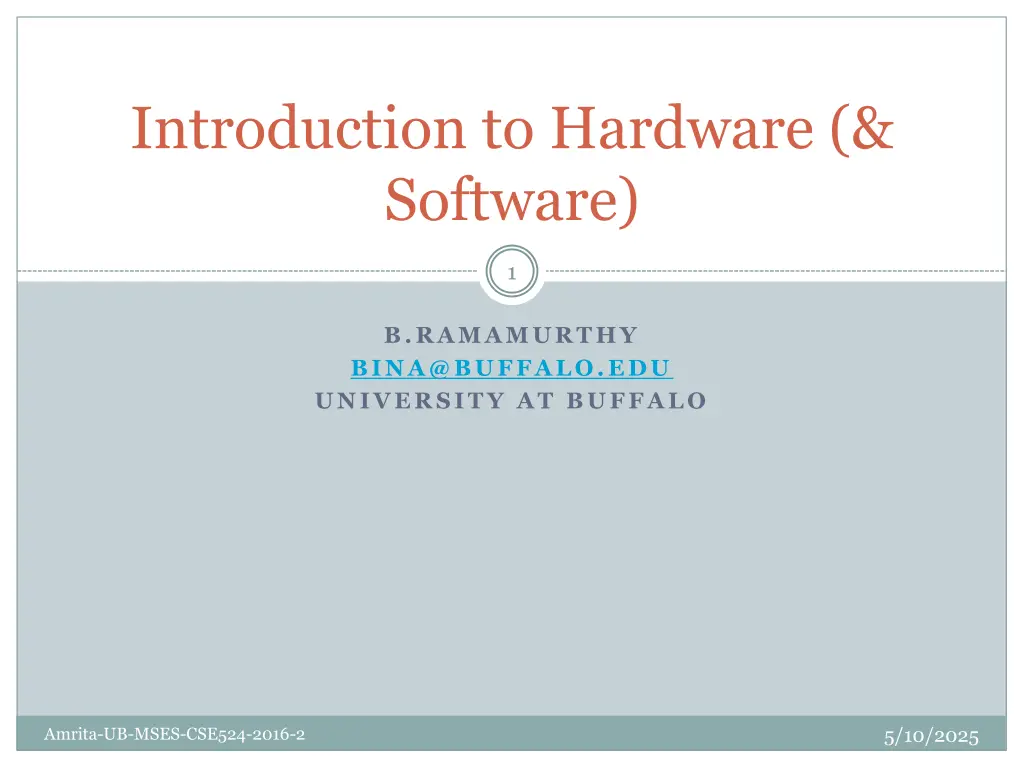
Introduction to Hardware and Software in Embedded Systems
Explore the fundamentals of hardware and software in embedded systems, covering topics such as block diagrams, general-purpose computers, microprocessors, and bus architecture. Learn about embedded control units, evolution of ECUs, and the significance of bus architecture in automobile systems.
Download Presentation

Please find below an Image/Link to download the presentation.
The content on the website is provided AS IS for your information and personal use only. It may not be sold, licensed, or shared on other websites without obtaining consent from the author. If you encounter any issues during the download, it is possible that the publisher has removed the file from their server.
You are allowed to download the files provided on this website for personal or commercial use, subject to the condition that they are used lawfully. All files are the property of their respective owners.
The content on the website is provided AS IS for your information and personal use only. It may not be sold, licensed, or shared on other websites without obtaining consent from the author.
E N D
Presentation Transcript
Introduction to Hardware (& Software) 1 B.RAMAMURTHY BINA@BUFFALO.EDU UNIVERSITY AT BUFFALO 5/10/2025 Amrita-UB-MSES-CSE524-2016-2
Topics 2 Block diagram of general purpose computer vs. embedded system Electronic Control Unit (ECU) Evolution of embedded control units 5/10/2025 Amrita-UB-MSES-CSE524-2016-2
General Purpose Computer System 3 Internal Memory External Memory Control Output Input ALU CPU CPU - Central processing unit ALU - Arithmetic and logic unit ROM - Read only memory RAM - Random access memory 5/10/2025 Amrita-UB-MSES-CSE524-2016-2
Microprocessor 4 CPU on a chip is a microprocessor. Microprocessors are the enabling hardware for realtime systems. Examples: vending machines, mobiles phones, alarm systems, washing machines, motor car engine controllers, heart monitors, microwave ovens all operate using embedded microcontrollers running dedicated software. 5/10/2025 Amrita-UB-MSES-CSE524-2016-2
Embedded System 5 Control ALU Internal memory CPU Ports This unit on a single chip is called a microcontroller 5/10/2025 Amrita-UB-MSES-CSE524-2016-2
Bus Architecture (in general purpose systems) 6 Parallel IO controller CPU DMA controller B U S Memory Interrupt controller Serial IO controller Why is this important? What is its relevance to automobile embedded system? 5/10/2025 Amrita-UB-MSES-CSE524-2016-2
Embedded control unit 7 These are embedded systems controlling various major components of a modern automobile Called ECUs 100 s of ECU in a typical electronic controlled modern car Each ECU is an embedded system with its own dedicated function 5/10/2025 Amrita-UB-MSES-CSE524-2016-2
Evolution of ECU 8 Long ago the automobiles controllers were all mechanical: levers and gears, relays, etc. : Generation 1 automobiles Some of the mechanical units were replaced by electronic devices. Eg. Electronic fuel injection system; : Generation 2. The few electronic control units were operating autonomously. In the next generation many ECUs were developed independently, and they also interacted with each other. Generation 3. Standards for ECUs were developed and platform-based system evolved resulting in Generation 4. Internal networks enabled ECUs to interact. Next generation involves outside networks. Traffic information, vehicle to vehicle communication, realtime weather conditions, road conditions, emergency situations. Generation 5. Bottom-line is that there is tremendous opportunities for standardization, R&D and production capabilities in this area. 5/10/2025 Amrita-UB-MSES-CSE524-2016-2
Activity#2 9 Identify some ECUs in a modern automobile and a possible (qualitative &/ quantitative) requirement. Example Justification 5/10/2025 Amrita-UB-MSES-CSE524-2016-2
Summary 10 We looked a very high level view of the hardware components in an embedded system. Also looked the relevance of embedded system modern automobile design. Most of the hardware such as system on a chip, VLSI will be covered other courses in this curriculum. In this course we will focus on software development for RTOS. 5/10/2025 Amrita-UB-MSES-CSE524-2016-2
Software in C Language 11 Lets solve the problem below using C. Consider the number game shown in the next few slides. Goal: To learn two approaches to solving this problem. Data-driven or table-driven approach Numbers are hard-coded and statically initialized Function-driven or generative approach Numbers are generated Which is better of the approaches? Why? Always consider alternative designs and choose the best for a given context. For example: a macro level decision for automobile models in a country: diesel vs petrol (gas as called in the USA); automatic vs manual gears 5/10/2025 Amrita-UB-MSES-CSE524-2016-2
The Number Game (1) 12 1 3 5 7 9 11 13 15 17 19 21 23 25 27 29 31 5/10/2025 Amrita-UB-MSES-CSE524-2016-2
The Number Game (2) 13 2 3 6 7 10 11 14 15 18 19 22 23 26 27 30 31 5/10/2025 Amrita-UB-MSES-CSE524-2016-2
The Number Game (4) 14 4 5 6 7 12 13 14 15 20 21 22 23 28 29 30 31 5/10/2025 Amrita-UB-MSES-CSE524-2016-2
The Number Game (8) 15 8 9 10 11 12 13 14 15 24 25 26 27 28 29 30 31 5/10/2025 Amrita-UB-MSES-CSE524-2016-2
The Number Game (16) 16 16 17 18 19 20 21 22 23 24 25 26 27 28 29 30 31 5/10/2025 Amrita-UB-MSES-CSE524-2016-2
Analysis 17 What is theory /concept behind this game? How did I arrive at the number you guessed? How can I automate this process? What is the data and what is the algorithm? How can we convey these to a computing machine? While a computer talks binary, we humans write programs in languages such as Java, C#, C++, Basic etc. Binary numbers (1 s and 0 s) is the number system used by the computer systems. We humans use decimal number system that has 10 distinct symbols (0,1,2,3,4,5,6,7,8,9) Your task: Write a C program to computerize this game. 5/10/2025 Amrita-UB-MSES-CSE524-2016-2
2 3 6 7 1 3 5 7 10 11 14 15 9 11 13 15 18 19 22 23 17 19 21 23 26 27 30 31 25 27 29 31 4 5 6 7 16 17 18 19 8 9 10 11 20 21 22 23 12 13 14 15 12 13 14 15 24 25 26 27 20 21 22 23 24 25 26 27 28 29 30 31 28 29 30 31 28 29 30 31 18 5/10/2025 Amrita-UB-MSES-CSE524-2016-2
